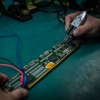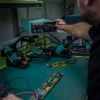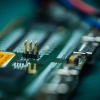NCBJ participates in research on cosmic explosions
2016.09.15 16:11 - adminEquipment developed and produced by NCBJ scientists and engineers may help to reveal nature of some of the most powerful explosions occurring in the Universe. The equipment launched on September 15, 2016 by the „Tiangong-2” (TG-2) Chinese space station is going to measure polarisation of gamma rays in Gamma-Ray Bursts (GRB). The equipment was developed within framework of the POLAR project, one of the projects run under the Swiss Contribution research programme.
The „Tiangong-2” (TG-2) Chinese space station was launched to a near-Earth orbit from the Jiuquan Satellite Launching Pad in China on September 15, 2016. Participants of that international project run mainly by China (Institute of High Energy Physics) include also Switzerland (INTEGRAL Science Data Centre, Département de Physique Nucléaire et Corpusculaire of the Genève University, Paul Scherrer Institute) and Poland (NCBJ). Among several experiments to be run by equipment on board of the station, the POLAR detector is going to measure polarisation of GRB photons. NCBJ involvement was made possible by the „IT for Astrophysical Observations in a Broad Energy Spectrum” PSAP grant (4.1 million PLN) financed from the Swiss Contribution research programme.
„The just launched POLAR detector will be the first device specially developed to study polarisation of GRB photons. The very few results acquired so far are subject to considerable uncertainties. However, it is just the polarisation which may reveal the mechanism responsible for the GRB bursts” – explained Professor Agnieszka Pollo, NCBJ Astrophysics Division Head. – „We expect the first scientifically useful data only in a few months, but we hope that the experiment will eventually help us to better understand nature of the most mighty cosmic explosions, which are among the most intriguing mysteries of our Universe”.
An idea of a small detector specially designed to study polarisation of GRB photons was developed by Nicolas Produit and Wojtek Hajdas in 2005. Contrary to other detectors designed to study GRBs (e.g. those launched on board of the SWIFT satellite), the POLAR detector can measure only gamma ray polarisation but is not able to localize burst origin points. The device comprises 1,600 longitudinal 6 x 6 x 176 mm scintillators laid out in a 40×40 square matrix. Effective registration area amounts to almost 400 cm2 and asymmetry may be measured. Scintillators are optimised for Compton-scattered gamma rays of energy within the 50…500 keV range. Light emitted by the scintillators is collected by 25 multi-anode photomultipliers. The detector is surrounded by a passive shield capable to block low-energy cosmic radiation. Detector field of view is very large.
Around ten scientists and engineers from NCBJ directly involved in the project for the last ten years have developed some key elements of the POLAR detector. The two major achievements include central trigger with its low-level software, and dedicated high voltage power supply.
„The trigger task is to initially analyse data acquired by all device sensors. It must effectively communicate with all 25 detector front-end electronic units and with satellite circuits. It also controls low- and high-voltage power supplies” – explains Eng. Dominik Rybka, MSc, central trigger designer (NCBJ Electronics & Detection Systems Division, and Paul Scherrer Institute).
Prototype of a high voltage power supply for 25 photomultipliers has also been designed in NCBJ. Polish scientists participated in all stages of the procedure to test and commission the detector; individual phases were carried out in European Synchrotron Radiation Facility (France), European Space Research & Technology Centre (The Netherlands), CERN (Switzerland), and in Terni (Italy). The POLAR team members are getting ready to analyse data acquired by the detector. It may well be that the data will be analysed using the supercomputer operated in Świerk Computer Centre.
„The POLAR project has been heavily drawing on our several-ten-years-long experience in nuclear physics and technology of constructing nuclear radiation detectors. Our high competences in that field greatly helped us to design, construct, test, and deploy the POLAR detector central trigger, its heart and a key element of the satellite data acquisition system” – said Dr. Krzysztof Kurek, NCBJ Director General. – „The project helped us to acquire unique know-how in developing space equipment. Our contribution has given us the right to access experimental data acquired by the satellite before other groups can analyse and interpret the data”.
Świerk scientists plan to use the acquired know-how also in other projects. Talks on a project to develop some innovative Cherenkov detectors and to implement some improved solutions to computer tomography (CT) are under way. CT methods are finding ever more applications in medicine, in particular in cancer diagnostics and therapy.
Even if GRBs were discovered more than 40 years ago, they are still a great mystery for scientists. First observations of extra-terrestrial bursts were made by US satellites that were launched during the cold war period to gather evidence on nuclear bomb explosions on Earth by monitoring gamma rays accompanying such explosions. Intense research showed soon that the bursts corresponded to the most powerful explosions in the Universe. Energy liberated in a GBR event within a very short time period and in a very confined space is so large, that even the mightiest nuclear bomb known on Earth is a trifle in comparison. As hypothesized by Professor Bogdan Paczyński, their sources located outside our Galaxy are often billions of light years away. Till these days their nature has not been fully clarified. Currently the most widely accepted hypothesis is that they follow either hypernovae explosions or collisions of some dense objects (e.g. two neutron stars, or a neutron star and a black hole). However, plenty of new observations are needed in order to confirm the hypothesis and gain a more detailed understanding.
NCBJ scientists have been actively involved in astrophysics and/or satellite projects like AKARI, JEM-EUSO and ATHENA (to name just a few) already for many years. Researchers running the „Pi of the Sky” project have been looking for optical signals accompanying GRBs.
























